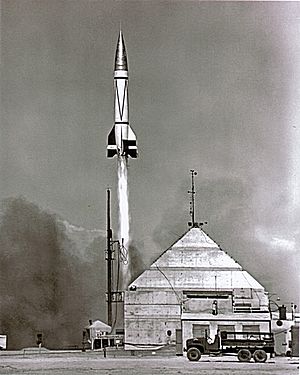Albert II (monkey) facts for kids

Albert II, a male rhesus macaque monkey, was the first primate and first mammal in space. He flew from Holloman Air Force Base in New Mexico, United States, to an altitude of 83 miles (134 km) aboard a U.S. V-2 sounding rocket on June 14, 1949. Albert died upon reentry after a parachute failure caused Albert's capsule to strike the ground at high speed. Albert's respiratory and cardiological data were recorded up to the moment of impact.
Albert II's flight, run by the Alamogordo Guided Missile Test Base and organized with the help of Holloman Air Force Base, followed the likely preflight death of Albert I before a 39 mi (63 km) high mesospheric flight aboard a V-2 rocket on June 11, 1948. The capsule was redesigned in-between flights to enlarge the cramped quarters experienced by Albert I.
Previous life launched into space
Before Albert II the only previous known living beings in space were fruit flies, launched by the United States in a V-2 rocket suborbital flight on February 20, 1947. The flies were recovered alive.
See also
- Monkeys and apes in space
- Animals in space
- Alice King Chatham, who designed Albert II's oxygen mask and harness
- Laika, a Russian space dog, the first animal to orbit the Earth (November 3, 1957)
- Ham, a chimpanzee, the first great ape in space (January 31, 1961)
- Yuri Gagarin, the first human in space and first primate to orbit the Earth (April 12, 1961)
- Enos, the first chimpanzee and third primate to orbit the Earth (November 29, 1961)

